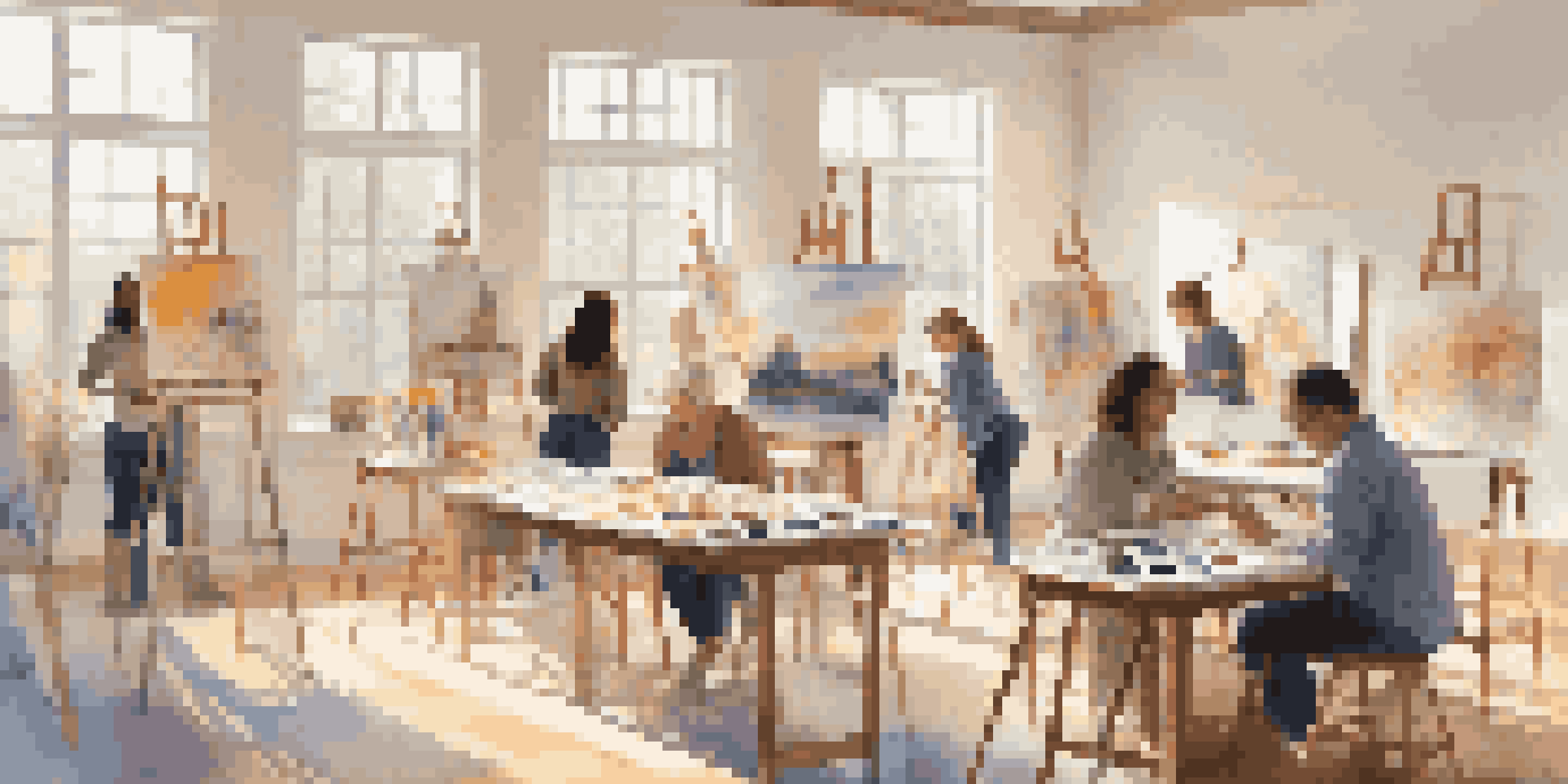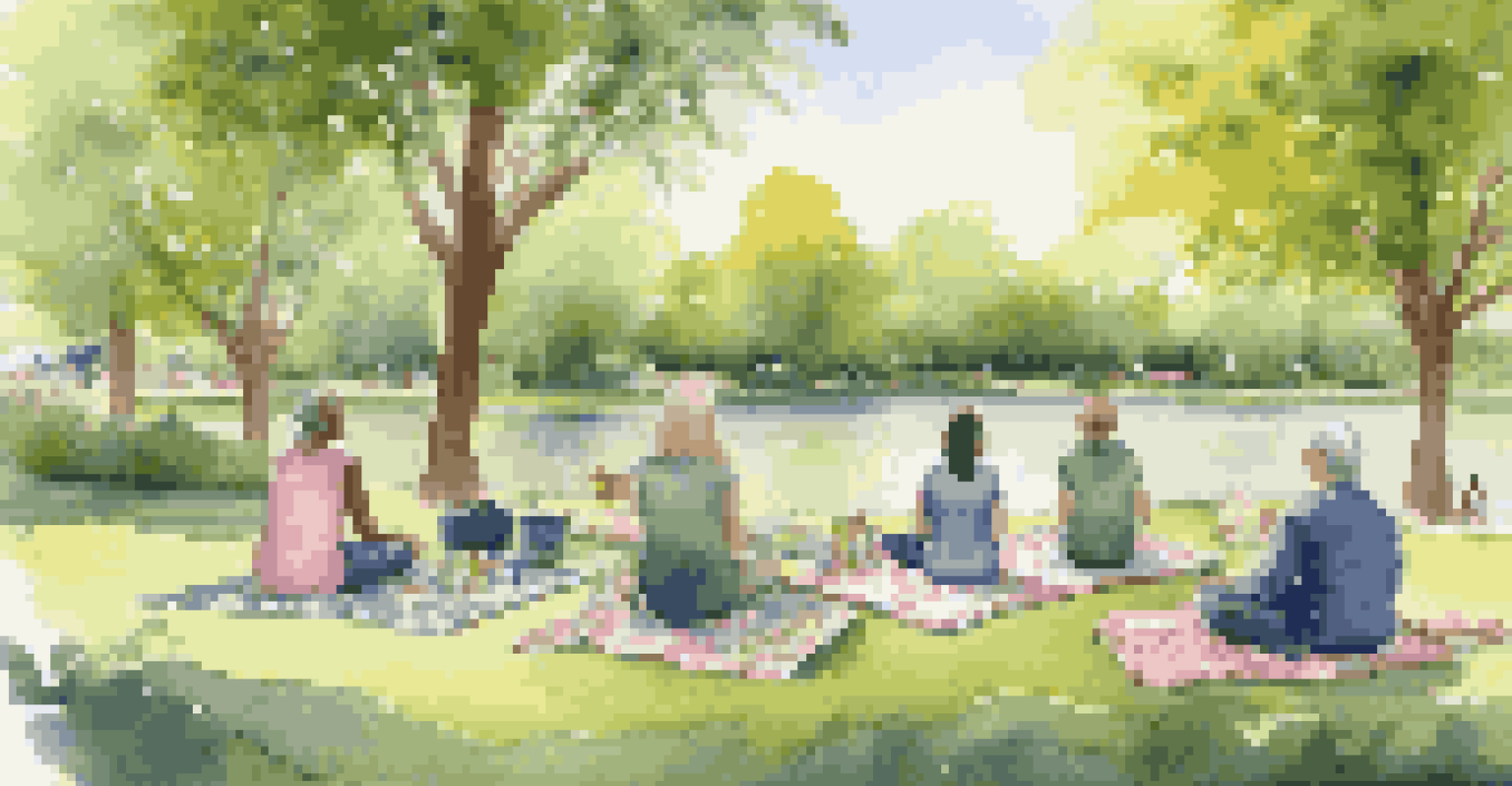The Role of Art Therapy in Suburban Mental Health

Understanding Art Therapy: A Gateway to Healing
Art therapy is a creative approach that uses artistic expression to help individuals process emotions and experiences. By engaging in activities like painting, drawing, or sculpting, people can communicate feelings that might be hard to express verbally. This method is particularly effective for those who may feel isolated in suburban settings, as it offers a safe space for exploration and connection.
Art enables us to find ourselves and lose ourselves at the same time.
In suburban areas, where mental health resources might be fewer than in urban environments, art therapy serves as a vital alternative. It breaks down barriers to communication and allows for personal reflection, which can be incredibly healing. This creative outlet can make therapy feel less intimidating, encouraging more individuals to seek help.
Moreover, art therapy can foster community ties. As participants share their artwork and stories, it creates bonds among them, promoting a sense of belonging. This communal aspect can be especially beneficial in suburbs, where social isolation can be a common issue.
The Benefits of Art Therapy for Mental Health
Art therapy offers numerous benefits, including reduced anxiety, improved mood, and enhanced self-esteem. Engaging in creative activities can trigger the release of endorphins, the brain's natural mood lifters, providing immediate relief from stress. This can be particularly valuable for suburban residents facing daily pressures from work, family, or other commitments.

Additionally, art therapy helps individuals develop coping strategies. Through the creative process, they can learn to manage difficult emotions and express themselves in healthier ways. For instance, someone might create a piece that represents their feelings of anger, helping them understand and work through that emotion rather than letting it fester.
Art Therapy Enhances Emotional Healing
Art therapy provides a creative outlet for individuals to express and process their emotions, making it a valuable resource for mental health.
Finally, art therapy can lead to personal growth. As individuals explore their creativity, they may uncover hidden talents or interests, boosting their confidence. This newfound self-awareness can encourage them to pursue other passions, contributing to a more fulfilling life.
Art Therapy Techniques Popular in Suburban Settings
Several techniques are commonly used in art therapy that resonate well with suburban populations. Collage-making, for example, allows individuals to piece together images and words that reflect their thoughts or experiences. This method is not only accessible but also encourages storytelling, making it easier for participants to share their narratives.
Creativity takes courage.
Another popular technique is guided imagery combined with drawing. Participants might visualize a peaceful place and then create a representation of it. This process not only promotes relaxation but also provides insight into their emotional states, helping therapists tailor their approaches more effectively.
Moreover, community mural projects can be an engaging way to incorporate art therapy into suburban environments. These collaborative efforts foster teamwork and a shared sense of accomplishment, while also beautifying the neighborhood. Engaging in such projects can help participants feel more connected to their community.
Challenges Facing Art Therapy in Suburban Areas
Despite its benefits, art therapy faces challenges, particularly in suburban areas. One significant hurdle is the stigma surrounding mental health. Many individuals may hesitate to seek therapy due to fear of judgment from neighbors or peers, which can deter them from exploring art therapy as an option.
Additionally, access to trained art therapists may be limited in suburban regions. Unlike urban areas that often have a higher concentration of mental health professionals, suburbs may have fewer resources. This scarcity can make it difficult for individuals to find appropriate support, leading to missed opportunities for healing.
Community Connection Through Art
Engaging in art therapy fosters community bonds, helping individuals feel less isolated and more connected in suburban environments.
Lastly, funding for art therapy programs can be insufficient. Many mental health initiatives rely on grants or community support, which may not be readily available in suburban settings. This can result in fewer programs being offered, leaving those in need with limited options.
Integrating Art Therapy into School Programs
Integrating art therapy into school programs can significantly benefit students in suburban communities. Schools can provide a safe environment where children and teenagers can express themselves creatively, helping to address their mental health needs early on. This proactive approach can foster resilience and emotional intelligence in young people.
Workshops and after-school programs that incorporate art therapy can also be instrumental in reducing stress among students. As academic pressures increase, having an outlet for creativity can help alleviate anxiety and promote a more balanced lifestyle. For instance, students might engage in group painting sessions to unwind after exams.
Moreover, involving parents in these programs can strengthen community ties. Family art nights or workshops can encourage collaboration and dialogue between generations, enhancing familial relationships. This can be especially important in suburban areas, where busy lifestyles often limit quality family time.
The Future of Art Therapy in Suburban Mental Health
The future of art therapy in suburban mental health looks promising, especially as awareness continues to grow. More individuals are recognizing the importance of mental well-being, leading to increased demand for alternative therapeutic methods. As a result, art therapy may become a more mainstream option for those seeking help.
Furthermore, advancements in technology are paving the way for innovative approaches to art therapy. Virtual art therapy sessions, for example, can reach those who may not have access to in-person therapy, breaking down geographical barriers. This can be a game-changer for suburban residents who might otherwise feel isolated.
Overcoming Barriers to Therapy Access
Despite its benefits, art therapy faces challenges such as stigma, limited access to trained professionals, and insufficient funding in suburban areas.
Lastly, community initiatives can play a crucial role in promoting art therapy. Local organizations and mental health advocates can collaborate to create accessible programs and raise awareness about the benefits of art therapy. By fostering a culture that values mental health, suburbs can become more supportive environments for those on their healing journeys.
Conclusion: Embracing Art Therapy for Better Mental Health
In conclusion, art therapy serves as a vital resource for enhancing mental health in suburban areas. Its ability to promote self-expression, foster community connections, and provide coping strategies makes it an invaluable tool for those facing emotional challenges. As awareness and acceptance of mental health issues grow, so does the potential for art therapy to thrive.
By integrating art therapy into schools and community programs, suburbs can create supportive environments that prioritize mental well-being. The future looks bright for art therapy, especially as technology continues to evolve and accessibility improves. Together, we can embrace this creative approach to healing.

Ultimately, art therapy is not just about creating art; it's about forging connections, understanding ourselves, and finding healing in the process. By recognizing its importance, we can work towards a healthier, more vibrant suburban community.